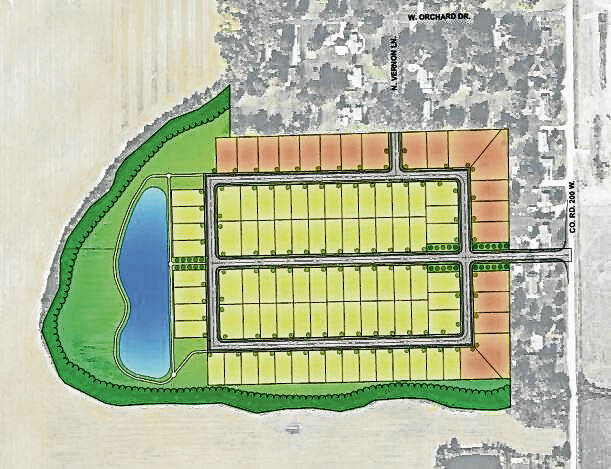FORTVILLE – A thin majority of planning authorities in Fortville recommends against a proposal for nearly 100 homes on the town’s south side.
Carmel-based Pyatt Builders is pursuing the development on 41 acres west of CR 200W and north of the Mt. Vernon Community School Corporation campus. Called Cushman Farms, the neighborhood would have 97 lots for single-family homes.
Adam Zaklikowski, Fortville planning and building director, noted at a Fortville Plan Commission meeting late last month that the site currently falls under one of the town’s residential zoning designations, meaning a housing development could go there as long as it followed that designation’s standards. Pyatt Builders is asking Fortville Town Council to rezone the site to a planned unit development, or PUD, however, which would establish standards specific to the development.
“Essentially, in exchange for smaller lots, the developer is willing to commit to higher standards as part of the PUD zoning,” Zaklikowski said.
He and Paul Claire of Pyatt Builders said those standards are some of the strongest in the Indianapolis metropolitan area.
“The standards that are included in this proposed PUD are pretty stringent,” Claire said, adding he and a colleague have worked extensively around the state’s capital, “and these are some of the more stringent standards in any of the cities and towns that we’ve worked in.”
The amount of vehicles Cushman Farms would bring to the area and how they’d get in and out of the neighborhood were concerns for several plan commission members.
The drive connecting the site to CR 200W, which would serve as the main entrance and exit for the proposed development, spans between two existing homes and has a 50-foot-wide right-of-way. That’s 5 feet narrower than the right-of-way for the streets proposed throughout Cushman Farms outlined in the PUD standards.
The only other proposed way in and out of Cushman Farms is North Vernon Lane through the Alfords addition to the north of the site, which residents of described as narrow during the plan commission meeting.
Zaklikowski said Fortville’s thoroughfare plan for CR 200W shows one lane in each direction with a center two-way left-turn lane. The tentative plan, he continued, is to widen the road to the east, giving enough space for the two-way left-turn lane that would allow northbound traffic to prepare to turn into Cushman Farms. Pyatt Builders would bear that cost, he added. He was confident the widening wouldn’t impede on the new trail along CR 200W’s east side, but said if it did, that would fall on the developer to remedy as well.
Zaklikowski also said the Hancock County Highway Department, which is responsible for roads in the Alfords addition, indicated roads through that neighborhood would not be projected to be widened because of Cushman Farms. He added the highway department would, however, want the developer to widen North Vernon Lane’s intersection with West Orchard Drive to the north within the existing right-of-way to improve accessibility for school buses and fire trucks.
Fortville Plan Commission members voted 4-3 to send Pyatt Builders’ rezone request to Fortville Town Council with a negative recommendation, with Brittney Layton, Scott Meyer, Jason Snider and Jason Stein voting in favor of the negative recommendation and Cheyenne Hoffa, Amandia Jeschke and Nathan Sturdevant voting against the negative recommendation.
“I don’t see any issues with the internal development,” Stein said. “I see issues with the fact that we’re really forcing ingress and egress at this neighborhood at basically the worst parts of the surrounding properties.”
Layton agreed.
“We really need another entrance to this neighborhood other than a small main entrance and a very, very tiny secondary entrance,” she said. Layton also expressed concerns over the proposed development exacerbating traffic backups on CR 200W and how that could impact emergency responses.
Sturdevant pointed to the overhaul coming to Mt. Vernon’s campus to the south, which includes a new private loop drive for additional vehicle queuing, indicating that should improve backups on CR 200W.
Several residents who live near the site spoke in opposition to the proposal, including those who live north and south of what would be the development’s main entrance and exit. Their driveways connect to that drive, and they worry about having to back out of what would become the primary ingress and egress to a 97-home neighborhood.
“I think putting in as many houses as we can in a certain amount of space is not always what’s best for the town,” said Lucas Shultz, who lives just north of the drive. “Adding more homes just so we can add more taxpayers is not always what’s best for the town.”
Residents of the Alfords addition also expressed concerns over additional traffic coming through their neighborhood.





